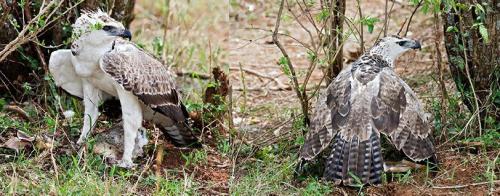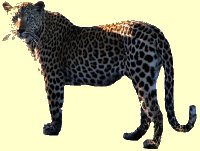Big Five Tours and Safaris Review
by Rohinton Mehta
(India)

In Masai Mara a spotted hyena was eating a kill made by a cheetah. There were three cheetahs but they dared not touch the kill. The hyena would let the cheetahs come almost five feet from the kill, but any further, and he would chase them away. The hyena ate all that he could and left. The vultures then finished off whatever remained.
Safari Operator Performance
Big Five Tours and Safaris’ big boss had visited India 2-3 years ago and had met me through a common friend. I had kept his visiting card.On the whole, the arrangements were good. However, here are some 'dislikes':
I did all the necessary correspondence with them. I always felt that they were not reading my emails properly. Their replies often did not address our queries. This was irritating, even after remitting the required amount, we had to follow up to ask whether they had received our money.
Our guide-cum-driver was one Mr John. He was very jovial, knew the territory like the back of his hand, was very well versed with knowledge of animals and birds.
We think he was instrumental in making our trip a success.
Accommodation
Nairobi - Amboseli - Mountain Lodge - Samburu - Sweetwater Tented Camp - Lake Nakuru - Lake Naivasha - Masai Mara - Back to Nairobi.We stayed at Serena lodges and Mara Lodges.
We felt that the Serena Lodges were more comfortable. We also felt that the people were more warm and courteous at Serena Lodges.
Food
Well, we really hogged! Cholesterol control went for a toss. All four of us are 'carnivorous'. So we had ham and bacon, sausages, eggs, fish, fruits, and whatever else was on the buffet table.Personally, what I enjoyed extremely was the (free) champagne at the breakfast table at Serena!
Wildlife
Buffaloes, elephants, lions, leopards, rhinos (black and white), cheetahs, monitor lizards, gerenuks, mongoose, Agama lizards, oryx, warthogs, dik-diks, sambars, giraffes (3 species), wildebeest.We also saw hippos, kudus, hyenas, wild boars, Colobus monkey, impala, baboons (yellow and olive), waterbuck, crocodiles, steenboks, impala, Thomson's gazelles, Gravies zebras, common zebras, chimps, ostrich, topi, gannets, and some others which I may have missed to write or could not identify.
Vultures, grouse, kingfishers, jacarandas, spoonbills, lapwings, horn bills, grey horned owl, African fishing eagles, weaver birds, tawny falcon, starlings, secretary birds, cormorants, cattle egrets, purple herons, yellow billed storks, ibis, flamingos, oxpeckers, pied crows, and some others which I could not identify.
A highlight was when we spotted an African Eagle with a hare that it had killed. As we were photographing it, it turned its back to us and spread his feathers and covered the entire kill as if to say 'don't eye my kill'.

It was my life's ambition to go to Africa. We just loved the places we went and had good photo opportunities.
Typical Day
We woke up at around 5am and were ready by 6 or 6.30. After a quick breakfast, we were ready to leave for the day. Spent 2-2½ hours in the mornings and the 2-2½ hours in the evenings in the parks.After returning, checked our images, cleaned the equipment for the next day, had our shower, had good dinner and off to bed by 10.00.
At the Mountain Lodge, we stayed awake till late in the night to see the animals at the water hole.
Other Activities
We visited a Masai village at Amboseli. The Masai were really nice. We were touched by their simplicity and wished their children were given some financial/food help by the government.The children were speaking in English, were eager to study (we visited their school). We had tears in our eyes, seeing their plight. (We donated some money for their school, but this info is not for any personal gains or advertisement or such). We wished we were very rich, so we could have helped them better.
Photography
I downloaded the free wildlife photography e-book - however knowledgeable one is about photography, it always helps to see the other person's point of view. I happen to be the Technical Editor of Smart Photography, India's leading photo magazine.Hence, technically, I was/am well aware of the photography and equipment part of the well-written e-book. However, it was a very good revision (after all, the more you know, the more you can forget!).
After reading the e-book, I got four bean-bags made to my specification. I think the bean-bags were most useful during the trip.
In spite of 35 years in photography, I don't have a very long lens. I would have loved to have my own 500mm f/4 or a 600mm f/4 or at least a 200-400mm f/4 zoom lens.
Even the 500mm lens that I borrowed on the last day from one of my friend in the group, was, at times, short. (I did not use the 500mm with the D300 even though it would have provided a longer 'reach'; I was interested to see how the D700 would perform with the 500mm in terms of edge to edge sharpness - on a full-frame body. I was impressed.)
I managed to borrow a Nikon 80-400mm from a friend (which I used about 75% of the time), which gave me an equivalent focal length of 600mm on my Nikon D300. Even then I often felt I needed a longer 'reach'.
Disappointments and Regrets
Because of the lack of rains, Amboseli in particular, was a disappointment. Dead animals at various places. We would rather see animals in good health.The timings of the safari (as allowed by the Park authorities) needs looking into. By 6pm, one is supposed to get out of the Park. The sun sets (in this season) around that time.
Late evenings are very good for landscapes, especially of setting sun, with animals in the foreground. The driver is obviously afraid to stay on longer because he could be fined by the authorities. Hence, the driver urges us to return back to the hotel. Not the driver's fault, but a problem of wrong timings at the Park.
We believe we lost many amazing landscape opportunities this way. Late evenings are also good because some animals get ready for hunting, which increases our chances of getting to see 'action'.
Since every Park in Africa is huge, it takes about 30-45 minutes to reach the entry/exit gate. Something could be done regarding the timings to let us be in the Parks at these times.
Tips and Advice
Carry two, or even three camera bodies. One with a wide-angle zoom, one with a standard zoom, and one with a long zoom. Get a nice camera bag from which it would be easy to pick up and put back the camera you do not need at that moment. Changing lenses in the field is not advisable due to the dust.If you can afford it, have only one photographer per vehicle. You will be able to avoid the movement the vehicle makes as others move about in the vehicle.
The bean bag was most useful. As indicated in the e-book, the tripod was of no use in the vehicle. The second most useful was the Nikon 80-400mm lens that I had borrowed. Without this lens, I don't think my trip would have been successful.
Definitely carry a video recorder. There will always be occasions where it is preferred to still images. We realised that when we were trying to photograph African eagles in mid-air. Their movement was too swift to catch with a still camera, but with a camcorder I was able to get the sequence.
| Rohinton's Safari Details: Rating: 9/10 Safari company used: Big Five Tours and Safaris (make an enquiry) Parks visited: Kenya: Amboseli, Samburu, Lake Nakuru, Lake Naivasha, Masai Mara Date of safari: 30 Sept for 11 days More Kenya reviews » |
More Amboseli Safari Reviews

Join in and write your own page! It's easy to do. How? Simply click here to return to Kenya Safari.


